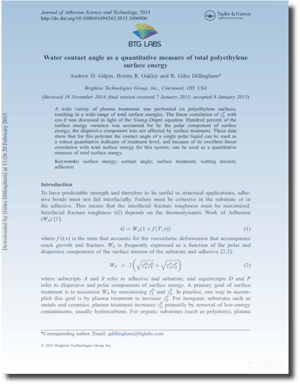A wide variety of plasma treatments were performed on polyethylene surfaces, resulting in a wide range of total surface energies.
 The linear correlation of
The linear correlation of ![]() with cos θ was discussed in light of the Young–Dupré equation. One-hundred percent of the surface energy variation was accounted for by the polar component of surface energy; the dispersive component was not affected by surface treatment.
with cos θ was discussed in light of the Young–Dupré equation. One-hundred percent of the surface energy variation was accounted for by the polar component of surface energy; the dispersive component was not affected by surface treatment.
These data show that for this polymer, the contact angle of a single polar liquid can be used as a robust quantitative indicator of treatment level, and because of its excellent linear correlation with total surface energy for this system, the polar contact angle can be used as a quantitative measure of total surface energy.
To have predictable strength and, therefore, to be useful in structural applications, adhesive bonds must not fail interfacially. Failure must be cohesive in the substrate or in the adhesive. This means that the interfacial fracture toughness must be maximized.
Download the paper: Water contact angle as a quantitative measure of total polyethylene surface energy

